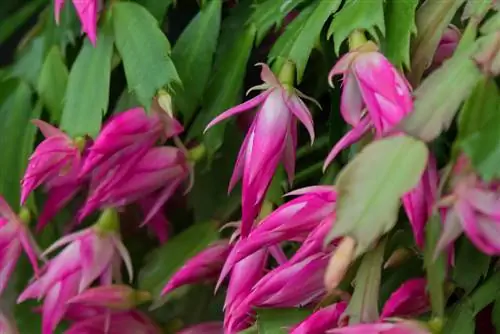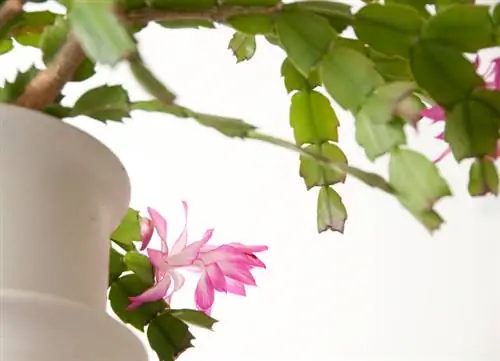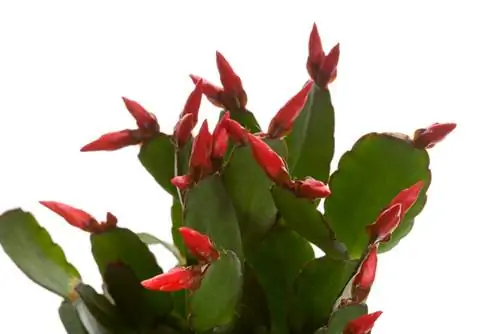- Author admin [email protected].
- Public 2024-01-05 20:48.
- Last modified 2025-01-23 11:21.
Just in time for Easter, the garden centers are filled with Easter cacti in different colors and shapes. Anyone who chooses this cactus plant should be familiar with its special requirements. Optimal care ensures that the plant will bloom again next Easter.

How do you care for an Easter cactus?
The Easter cactus (Hatiora x graeseri) is a popular, non-poisonous cactus plant and blooms at Easter. The colorful range of flowers ranges from red and pink to orange, yellow and white. The cactus requires a cool, bright resting phase, well-drained substrate and a partially shaded location for optimal care and flower formation.
Origin
The Easter cactus was created from a breeding between two species of the genus Hatiora. Hatiora gaertneri and Hatiora rosea served as parent plants for this popular ornamental plant with the Latin name Hatiora x graeseri.
Both species are originally from Brazil, where they can be found in Paraná, Santa Catarina and Rio Grande do Sul. The cactus plants thrive at altitudes between 350 and 2,000 meters. They shape the vegetation of the cloud forest. Hatiora gaertneri is often cultivated as a single species and is also offered as an Easter cactus by many specialist retailers.
Growth
Easter cacti develop several upright to hanging main shoots that branch out profusely. This growth creates a bush-like shape. The shoots are composed of numerous links that appear flatly compressed or three- to hexagonal in cross-section. Fresh stems are initially colored red. As they age, they turn dark green. The shoot segments grow between two and seven centimeters long. Its edge is notched.
Bloom
Hatiora x graeseri develops broad, funnel-shaped or bell-shaped individual flowers that are between three and five centimeters long. Their petals are fused into a short tube at the bottom and spread out in a star shape at the top. The flowers arise at the tips of the individual shoot segments and sit individually or in small groups.
The flowers open during the day to attract insects with their bright colors. The color palette ranges from red and pink to orange, yellow and white. The red tones range from dark to light in every imaginable shade. When breeding, the focus is on color and abundance of flowers. There are varieties with strikingly large flowers or lush flowers.
Flowering time
The cactus plants base their flower development on environmental influences. In order for the plants to be stimulated to flower, a rest period is necessary. While rainy and dry seasons influence the growing season in natural habitats, you can follow the seasons when cultivating at home.
In the winter months, fertilizer applications and irrigation units are stopped so that the plant slows down its metabolism. Next spring, the plants will be encouraged to grow and produce flowers by watering and providing nutrients more frequently.
After the dormant phase, the plants adjust to the available daylight before flowering. The short-day plants form flower buds when the amount of light per day does not exceed ten hours. Plants sold in stores are cared for appropriately so that they bloom in time for Easter.
Fruit
After the flowers have withered, Easter cacti produce yellowish or red fruits. They appear elongated or spherical and may be flattened. The bare pericarp encloses several black to brownish seeds.
leaves
The Easter cactus is special from an evolutionary perspective because it does not develop typical leaves. Its foliage has deteriorated significantly and is no longer visible. The plants have continually minimized leaf size to reduce the area of evaporation. This adaptation was necessary so that the cacti enjoyed a growth advantage in their habitats. They lose less water in dry times.
Easter cacti form so-called areoles. They are reshaped and heavily compressed short shoots that appear as felty cushions. These structures arise in the leaf axils instead of the leaves. They sit along the segment edges and at the shoot tip and are covered with fine yellowish-brown bristles. At the tip of older shoot members, new segments or flowers develop from the areoles because they have tissue that can divide.
Function of the areoles:
- Thorns protect against predators
- leafless shoots evaporate less water
- sleeping buds
Usage
Easter cacti are cultivated as houseplants. They decorate standing tubs or hanging pots in living rooms. In the bedroom, the cactus plant doesn't just take on visual functions. Its air-purifying properties have a positive effect on the indoor climate. The characteristic shape is an eye-catcher in every room. The exotic plant feels at home in the bathroom because there is high humidity here.
The plant thrives in greenhouses and winter gardens. During the summer months, the Easter cactus likes to spend its time outdoors in a protected and sunny location. In this way, the plant decorates balconies, terraces and house entrances.
Is Easter cactus poisonous?
The plants of the genus Hatiora including the Easter cactus are not poisonous. The plant is therefore particularly suitable for children's rooms or households where pets live. There is no risk of poisoning for birds, dogs, cats or rabbits. You should note that budgies or cockatiels can quickly destroy the flowers of the Easter cactus if they inspect the plants because of their curiosity.read more
Which location is suitable?
Hatiora hybrids prefer a partially shaded location with bright conditions between May and October. The plants like a place where the sun shines morning and evening. The cactus plant can tolerate blazing sun as long as the pot is not placed directly behind the window pane. If your Easter cactus grows on the south window, there should be at least 50 centimeters between the pane and the plant. In the sun the shoots turn reddish.
The Easter cactus can be placed outside from spring to autumn. Place the plant in a protected spot in partial shade. As soon as the temperatures drop below ten degrees Celsius at night, you should bring the cactus inside.read more
What soil does the plant need?
The plants need a well-drained substrate with a pH value below seven. You can put together a mixture yourself and create a coarse-grained soil in this way. Commercially available potting soil or cactus soil is suitable as a base. Alternatively, you can use peat-free tomato soil. For greater permeability, sand, perlite, clay granules or diatomaceous earth are used.
The perfect mix:
- two to three parts of soil
- a part of sand
- one part of clay granules
Sowing
When your Easter cactus blooms, you can pollinate the flowers with a paintbrush. Strip the stamens with a fine brush and spread the pollen over a stigma. Self-pollination within a flower is possible. Ideally, the seeds' genetic material comes from two different plants. It can take up to six months before the fruit is ripe and can be harvested.
Remove the seeds from the fruit and let them air dry for a few days. Scatter the seeds onto moist growing substrate and cover the planter with a transparent film. This ensures a constant temperature and high humidity. Place the container in a bright place where the temperature is between 22 and 26 degrees Celsius. The seeds germinate after three weeks. If the young plants are two to three centimeters high, they should slowly be acclimated to room temperature.
Cuttings
Cuttings enable successful and easy propagation of Easter cacti. Cut shoots from a mature specimen. The cutting should be between ten and 15 centimeters long and have three to four limbs. Be careful not to crush the conductors in the segments. Use a sharp knife to achieve a clean cut.
Let the interface air dry for three to four days before inserting the cutting into growing substrate. Use a sandy, humus-rich substrate consisting of two parts potting soil and one part sand. Keep the substrate evenly moist. Place the cutting in a bright place without direct sun. At temperatures between 22 and 25 degrees Celsius, it takes four to five weeks until the first roots emerge.
Alternatively, you can place the cutting in a water-filled glass container with a water level of between three and four centimeters. To prevent rot, the water should be changed regularly.
In the greenhouse
A heated greenhouse provides optimal conditions for the Easter cactus. You can always adjust the temperature to suit the plant's needs. A high level of humidity is guaranteed in the greenhouse, so that the number of watering units is reduced. As an alternative, you can use a space-saving cold frame. Milk panes ensure diffuse lighting conditions and protect against the sun. However, the box should not be left in direct sunlight.
Watering the Easter cactus
Outside the dormant phase, the Easter cactus needs an evenly moist substrate. The sensitive roots cannot tolerate waterlogging. Make sure that no excess water remains in the saucer after the watering sessions. The top layer of soil is allowed to dry between waterings.
How often you need to water the Easter cactus depends on the temperature, age of the plant and size of the pot. In mid-summer you should check the substrate more often so that the root ball does not dry out completely. Adult specimens require more water than young plants. In smaller pots the moisture is used up more quickly than in large containers.
Cut Easter cactus correctly
Regular pruning is not necessary to maintain the plant's vitality. You can shorten the Easter cactus if its shoots grow too long. Pruning measures should be carried out after the flowering period. Otherwise there is a risk that the plant will drop flowers and buds. Use a clean and sharp knife to avoid damaging the links. Cut shoots can be used for rejuvenation.read more
Fertilize the Easter cactus properly
If you let your Easter cactus rest during the winter months, fertilization will begin in April. Give the plant some liquid fertilizer via the irrigation water every month. If you bought the cactus or just repotted it, it does not need fertilization in the same year.
Repotting
Every two to three years the Easter cactus can be planted in a larger container. If you don't want the ornamental plant to grow larger, you can do without a larger pot and just change the substrate. Make sure the pot has a drain hole. Shards of pottery or stones are placed on the bottom of the pot as drainage. Since the shoot segments break off easily, you should touch the plant at the base.read more
Wintering
The Easter cactus spends its winter rest from November in a bright place where the temperature is ten degrees Celsius. Slightly higher temperatures do not cause any problems. During this time, limit watering. The nutrient supply is stopped. Winter rest ends with bud formation. At this point the Easter cactus is slowly becoming accustomed to higher temperatures.
Pests
The most common pests on Easter cacti include scale insects, spider mites and mealy bugs. They prefer to reproduce on plants that are placed above the heater during the winter months. A change of location is the first step. Remove the pests with the help of a sharp jet of water or by carefully wiping with a cloth. The shoots can be sprayed with oil-based products so that lice and mites are killed by the fine oil film.
Fungal infestation
If the roots rot in substrate that is too wet, fungi can spread. The spores colonize rotten plant parts and promote further rotting processes. This causes the plant's nutrient and water balance to become imbalanced, causing flowers and buds to fall off or shoots to wither. They shrink and turn yellowish.
As a preventive measure, you should make sure that the substrate does not get too wet. Root rot is common during overwintering. As soon as signs of damage appear, you should check the plant for root damage and place it in dry substrate.
Easter cactus not blooming
After you have purchased a blooming Easter cactus in spring, care is important to maintain the special blooming period. You can influence flower development yourself by controlling the amount of light about two to three months before the desired flowering time. Make sure that the plant does not receive more than ten hours of light per day during this time. Place a cardboard box (€9.00 on Amazon) over the plant when the number of hours has been reached. The next morning the box is removed for the next ten hours.
If you want the cactus to bloom in time for Easter, the months between late autumn and the end of winter are recommended as a resting period. The break should last six to eight weeks. During this time, care measures will be reduced. The Easter cactus spends time in a cool and bright place with a temperature of ten degrees Celsius.
As soon as the first buds appear, the location must not be changed, otherwise the Easter cactus will drop its flowers. When the flowers are opening, the temperature should not rise above 23 degrees Celsius. Immediately after flowering, the ornamental plant gets a second rest period.read more
Tip
Each plant prefers a different direction. Decorate east or west-facing window sills with the Easter cactus. Spurge plants are suitable for south-facing windows and the African dragon tree feels particularly at home on north-facing windows.
Varieties
- Hatiora salicornioides: Sparsely branched shrub with rounded shoot segments, woody. Flowers yellow. Up to 100 centimeters high.
- Hatiora epiphylloides: Epiphytic growing species with sulfur yellow flowers. Shoot segments short, up to three centimeters.
- Hatiora herminiae: Forked, branched growth habit. Flowers pink to magenta. Growth height up to 30 centimeters.






